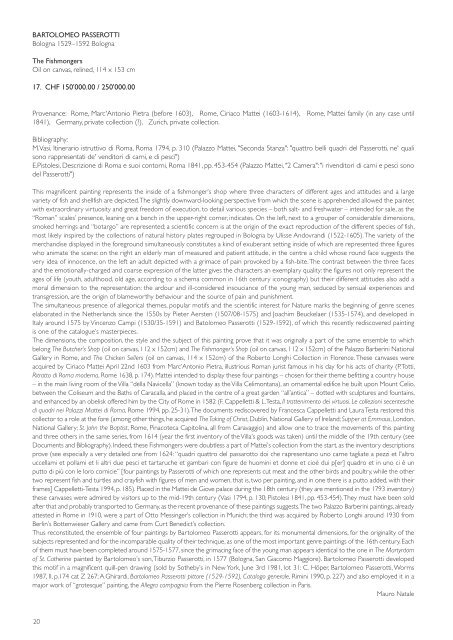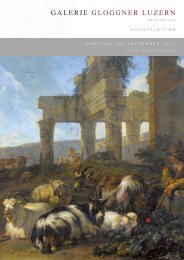Auktionskatalog 2010 (2'853 kB - pdf) - Galerie Gloggner Luzern
Auktionskatalog 2010 (2'853 kB - pdf) - Galerie Gloggner Luzern
Auktionskatalog 2010 (2'853 kB - pdf) - Galerie Gloggner Luzern
Sie wollen auch ein ePaper? Erhöhen Sie die Reichweite Ihrer Titel.
YUMPU macht aus Druck-PDFs automatisch weboptimierte ePaper, die Google liebt.
BARTOLOMEO PASSEROTTI<br />
Bologna 1529–1592 Bologna<br />
The Fishmongers<br />
Oil on canvas, relined, 114 x 153 cm<br />
17. CHF 150'000.00 / 250'000.00<br />
Provenance: Rome, Marc'Antonio Pietra (before 1603), Rome, Ciriaco Mattei (1603-1614), Rome, Mattei family (in any case until<br />
1841), Germany, private collection (?), Zurich, private collection.<br />
Bibliography:<br />
M.Vasi, Itinerario istruttivo di Roma, Roma 1794, p. 310 (Palazzo Mattei, "Seconda Stanza": "quattro belli quadri del Passerotti, ne' quali<br />
sono rappresentati de' venditori di carni, e di pesci")<br />
E.Pistolesi, Descrizione di Roma e suoi contorni, Roma 1841, pp. 453-454 (Palazzo Mattei, "2 Camera": "i rivenditori di carni e pesci sono<br />
del Passerotti")<br />
This magnificent painting represents the inside of a fishmonger’s shop where three characters of different ages and attitudes and a large<br />
variety of fish and shellfish are depicted. The slightly downward-looking perspective from which the scene is apprehended allowed the painter,<br />
with extraordinary virtuosity and great freedom of execution, to detail various species – both salt- and freshwater – intended for sale, as the<br />
“Roman” scales’ presence, leaning on a bench in the upper-right corner, indicates. On the left, next to a grouper of considerable dimensions,<br />
smoked herrings and “botargo” are represented; a scientific concern is at the origin of the exact reproduction of the different species of fish,<br />
most likely inspired by the collections of natural history plates regrouped in Bologna by Ulisse Andovrandi (1522-1605). The variety of the<br />
merchandise displayed in the foreground simultaneously constitutes a kind of exuberant setting inside of which are represented three figures<br />
who animate the scene: on the right an elderly man of measured and patient attitude, in the centre a child whose round face suggests the<br />
very idea of innocence, on the left an adult depicted with a grimace of pain provoked by a fish-bite. The contrast between the three faces<br />
and the emotionally-charged and coarse expression of the latter gives the characters an exemplary quality: the figures not only represent the<br />
ages of life (youth, adulthood, old age, according to a schema common in 16th century iconography) but their different attitudes also add a<br />
moral dimension to the representation: the ardour and ill-considered insouciance of the young man, seduced by sensual experiences and<br />
transgression, are the origin of blameworthy behaviour and the source of pain and punishment.<br />
The simultaneous presence of allegorical themes, popular motifs and the scientific interest for Nature marks the beginning of genre scenes<br />
elaborated in the Netherlands since the 1550s by Pieter Aersten (1507/08-1575) and Joachim Beuckelaer (1535-1574), and developed in<br />
Italy around 1575 by Vincenzo Campi (1530/35-1591) and Batolomeo Passerotti (1529-1592), of which this recently rediscovered painting<br />
is one of the catalogue’s masterpieces.<br />
The dimensions, the composition, the style and the subject of this painting prove that it was originally a part of the same ensemble to which<br />
belong The Butcher’s Shop (oil on canvas, 112 x 152cm) and The Fishmonger’s Shop (oil on canvas, 112 x 152cm) of the Palazzo Barberini National<br />
Gallery in Rome, and The Chicken Sellers (oil on canvas, 114 x 152cm) of the Roberto Longhi Collection in Florence. These canvases were<br />
acquired by Ciriaco Mattei April 22nd 1603 from Marc’Antonio Pietra, illustrious Roman jurist famous in his day for his acts of charity (P. Totti,<br />
Ritratto di Roma moderna, Rome 1638, p. 174). Mattei intended to display these four paintings – chosen for their theme befitting a country house<br />
– in the main living room of the Villa “della Navicella” (known today as the Villa Celimontana), an ornamental edifice he built upon Mount Celio,<br />
between the Coliseum and the Baths of Caracalla, and placed in the centre of a great garden “all’antica” – dotted with sculptures and fountains,<br />
and enhanced by an obelisk offered him by the City of Rome in 1582 (F. Cappelletti & L. Testa, Il trattenimento dei virtuosi. Le collezioni secentesche<br />
di quadri nei Palazzi Mattei di Roma, Rome 1994, pp. 25-31). The documents rediscovered by Francesca Cappelletti and Laura Testa restored this<br />
collector to a role at the fore (among other things, he acquired The Taking of Christ, Dublin, National Gallery of Ireland; Supper at Emmaus, London,<br />
National Gallery; St. John the Baptist, Rome, Pinacoteca Capitolina, all from Caravaggio) and allow one to trace the movements of this painting<br />
and three others in the same series, from 1614 (year the first inventory of the Villa’s goods was taken) until the middle of the 19th century (see<br />
Documents and Bibliography). Indeed, these Fishmongers were doubtless a part of Mattei’s collection from the start, as the inventory descriptions<br />
prove (see especially a very detailed one from 1624: “quadri quattro del passarotto doi che rapresentano uno carne tagliate a pezzi et l'altro<br />
uccellami et pollami et li altri due pesci et tartaruche et gambari con figure de huomini et donne et cioè dui p[er] quadro et in uno ci è un<br />
putto di più con le loro cornicie” [four paintings by Passerotti of which one represents cut meat and the other birds and poultry, while the other<br />
two represent fish and turtles and crayfish with figures of men and women, that is, two per painting, and in one there is a putto added, with their<br />
frames] Cappelletti-Testa 1994, p. 185). Placed in the Mattei de Giove palace during the 18th century (they are mentioned in the 1793 inventory)<br />
these canvases were admired by visitors up to the mid-19th century (Vasi 1794, p. 130; Pistolesi 1841, pp. 453-454). They must have been sold<br />
after that and probably transported to Germany, as the recent provenance of these paintings suggests. The two Palazzo Barberini paintings, already<br />
attested in Rome in 1910, were a part of Otto Messinger’s collection in Munich; the third was acquired by Roberto Longhi around 1930 from<br />
Berlin’s Bottenwieser Gallery and came from Curt Benedict’s collection.<br />
Thus reconstituted, the ensemble of four paintings by Bartolomeo Passerotti appears, for its monumental dimensions, for the originality of the<br />
subjects represented and for the incomparable quality of their technique, as one of the most important genre paintings of the 16th century. Each<br />
of them must have been completed around 1575-1577, since the grimacing face of the young man appears identical to the one in The Martyrdom<br />
of St. Catherine painted by Bartolomeo’s son, Tiburzio Passerotti, in 1577 (Bologna, San Giacomo Maggiore). Bartolomeo Passerotti developed<br />
this motif in a magnificent quill-pen drawing (sold by Sotheby’s in New York, June 3rd 1981, lot 31: C. Höper, Bartolomeo Passerotti, Worms<br />
1987, II, p.174 cat Z 267; A.Ghirardi, Bartolomeo Passerotti pittore (1529-1592), Catalogo generale, Rimini 1990, p. 227) and also employed it in a<br />
major work of “grotesque” painting, the Allegra compagnia from the Pierre Rosenberg collection in Paris.<br />
Mauro Natale<br />
20




